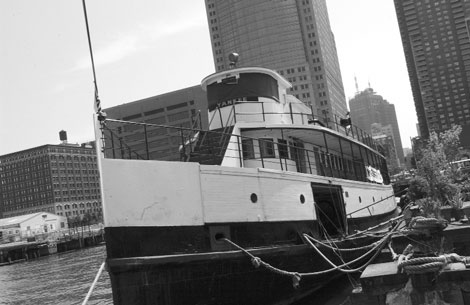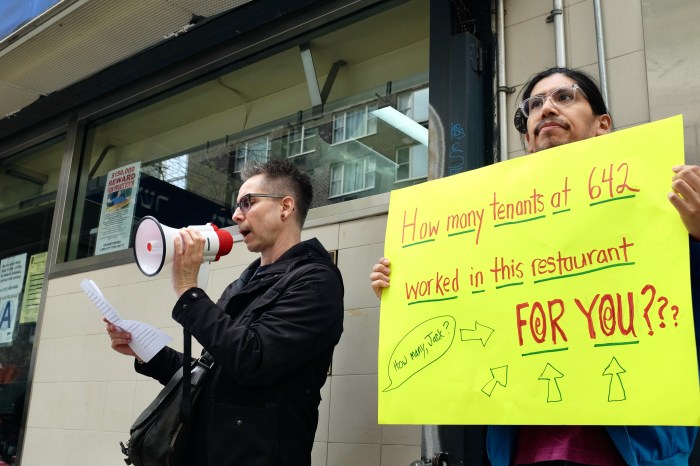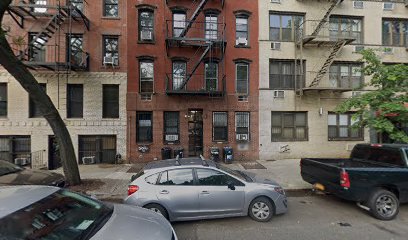By Lincoln Anderson
;’
A plan for interim recreational uses for Pier 40 will be presented to the Hudson River Park Trust’s board of directors in “a month or so,” reported Robert Balachandran, the Trust’s president, at the agency’s board meeting last Thursday. Balachandran previously had said the interim park uses on Pier 40 will include athletic fields to the greatest extent possible, though he did not discuss this further last Thursday.
The board also approved new tennis courts at Spring St. and adopted a policy of not permitting ship keepers or others to live aboard historic vessels in the park for more than six months at a time.
The issue of the aborted Pier 40 process was raised by former state Senator Franz Leichter, a board of directors member. Speaking via a phone hookup from Washington, D.C., Leichter questioned the process by which the Trust decided on June 9 not to pick any of several competing private developers’ plans for the W. Houston St. pier, but instead to develop the pier with interim recreational and park uses and put the project out for bid again in a few years.
“I’m concerned that decisions have been made on Pier 40 that were not done in an open way,” Leichter said. “We need to take this up at one of our board meetings in an open manner.”
Julie Nadel, another board member, added, “Where was the board’s action? This is a fairly significant non-action by the board. How much money are we going to spend on this interim plan?”
Balachandran said they don’t know the interim Pier 40 plan’s cost right now, but that consultants are studying this. He said that at one point or another, all the board members had discussions either with him or James Ortenzio, the board’s former chairperson, regarding the decision not to pick a developer right now for Pier 40.
After these discussions, “There was a small meeting, and they made the decision,” Balachandran said. “Believe me, this wasn’t something that was ordered by Robert Balachandran,” he added. “It was done with the chairperson.”
Meanwhile, Lawrence Goldberg, president of the Hudson River Park Advisory Council, in his remarks to the board, called the Pier 40 process “a failure.”
“It was mandated to have a developer and we don’t have a developer,” Goldberg said. “The fact that we’re not going to [develop the pier] and we’re starting again with interim uses is a failure.”
Under an amendment to the Hudson River Park Act, the Trust was supposed to pick a developer by the deadline of June 15.
However, Joe Rose, a board of directors member and a member of the City Planning Commission, said, “To pick the wrong developer would be more problematic than not picking any developer.” Rose said the board didn’t want to be “locked into something that was less than optimal. I don’t think we felt comfortable [rushing to meet] what seemed like an artificial constraint.”
Balachandran said a request for proposals to operate the parking on the pier will be issued. For the last seven years, C&K Properties’ partners Ben Korman and Meier Cohen have held the master lease for the pier and operated the parking and other commercial uses. C&K currently generate $4.5 million annually in revenue for the Trust.
Current uses on the pier that do not conform with the Hudson River Park Act, such as FedEx, Academy bus and the Police Department’s Barrier Unit, will have to vacate the pier by the end of the year.
Tennis courts in play
In addition, there will be tennis in about two months in Hudson River Park but not tenants (as in ship keepers) any time soon, and possibly never. The directors voted to approve three new tennis courts to be built in the park at Spring St., west of the West Side Highway. They also voted to approve guidelines for docking historic vessels in the park, including a prohibition against ship keepers living onboard.
The Lower Manhattan Development Corp., which had already approved the tennis courts project before it was voted on by the Trust, will reimburse the cost of building them. There will be one single and two double courts. The work is scheduled to start within the next two months and should be done fairly quickly.
The project was put out to bid and a contract was awarded for $560,000, not to exceed $616,000. The courts would be asphalt with a thin, rubberized surface. It wasn’t immediately clear if the courts would be free to use, but previously courts in Battery Park City that were on Trust property were free to use on a first-come-first-served basis with a one-hour limit.
There was a lengthy discussion on whether the amount was too much to spend on three tennis courts that will be interim and probably demolished after three years to allow repair of the bulkhead, or seawall, along the Hudson River Park’s Segment 3. Currently, the area is barren blacktop.
Board member Bernadette Castro, state Parks commissioner, conveyed the thoughts of board member Madelyn Wils, chairperson of Lower Manhattan’s Community Board 1 and a member of the L.M.D.C., who was out of town. According to Castro, Wils felt it would be “more prudent” to locate the tennis courts on Pier 40 at Houston St., where they would have “five seasons” — which Wils later said is her estimate of the length of time before the pier will be redeveloped.
Wils, in a phone interview on Monday, said she was concerned about “spending public dollars on a project that could be very short term,” which is why she suggested putting the courts on Pier 40. She said her estimate of the length of time before Pier 40 is developed is based purely on her own calculation of how long it would take to put interim uses on the pier, have them used for a few years and then put out a new request for proposals for Pier 40.
“I’m guessing here,” Wils said. “Nothing here is anyway a model the Trust is using.”
Others were also concerned about the project’s cost. Georgette Mosbacher, another Trust board member and a top Republican fundraiser, said, “We’re going to spend $600,000 on three tennis courts that will only last three years? I find that absolutely staggering.”
However, Trip Dorkey, the Trust’s new chairperson, said the mayor and the governor had approved the money through the L.M.D.C. in order to help Downtown recreation.
“If we don’t take this money, they could take it back, consider other uses,” Dorkey noted. “I hate to say it’s other people’s money, but it’s other people’s money.” He also said that the governor had put out a press release on the tennis courts. Dorkey downplayed the construction cost, noting, “It’ll work out to less than $1 per person” who plays tennis on the courts.
Balachandran said they had made “great strides” in Soho and Tribeca, in Segment 3, in terms of recreational uses, including the new batting cages and a skateboard park at N. Moore St. There is also a new full-length basketball court just north of Chambers St. An ice-skating rink, paid for by the L.M.D.C., will be coming to the park near N. Moore St. next winter. Balachandran said putting the tennis courts on Pier 40 could complicate matters in the development of interim recreational space on the pier.
“I would hate to muddy that water,” Balachandran said.
Added Dorkey, putting the courts on the pier “commits us to doing something we may or may not want to do on Pier 40.”
Leichter wondered if there had been any thought given to a bubble for winter use.
Another director, former Parks Commissioner Henry Stern, said interim uses can be very hard to move once established; but it was explained that in the park’s master plan this spot is actually where tennis courts are planned, since it is wide enough.
Initially, the board voted to table the item till their next meeting, but a few board members arrived late and Dorkey asked for another discussion and vote.
Teddy Roosevelt, IV, a director, said he didn’t want to “embarrass” the governor by turning down the funds. Mosbacher said she didn’t realize a press release had been issued. In the end, the board voted to approve the tennis courts for Spring St.
No ship dwellers
The Trust also voted to approve guidelines for berthing historic boats in the park. The guidelines keep with the Hudson River Park Act, which forbids residential use of the park, in that people will not be allowed to live on the boats docked on a long-term basis at piers in the park.
Piers slated for historic vessels include Pier 25 at N. Moore St. in Tribeca, Pier 54 at W. 13th St. and Pier 97 at W. 57th St. at the north end of Hudson River Park.
Nadel, noting it was an “issue close to my heart,” said she felt the guidelines need more review and that, as they are now, they will adversely affect historic ships in the park. Nadel wants ship keepers to be allowed to live on at least some of the ships, as is done for the three ships at South St. Seaport. A ship keeper also lives near the Intrepid Air Space Museum, she noted.
Under the guidelines, historic ships from foreign countries that come here for festivals would be allowed to dock for up to six months with their crew aboard, but the Trust would not allow anyone to live on a ship longer than that.
Nadel said it’s necessary for the ships’ protection to have ship keepers, and that for a waterfront park things should be done to encourage the docking of historic ships.
“We don’t want houseboats, but a ship is not something you can just lock up and leave for the night,” she said.
Dorkey said they are “guidelines, not rules” and that there is some leeway, but stressed that, “One of the clear mandates of this Trust is no residences in the park.”
Balachandran said the issue has been “vexing” and was something that legislators went “around and around and around on” in Albany when the Hudson River Park Act was drafted six years ago.
“As a general provision, we do echo what’s said in the Hudson River Park Act about living in the park,” he said, adding that situations like a boiler blowing up, for example, could merit someone being on board a ship to repair it or safeguard it.
Laurie Silberfeld, the Trust’s counsel, said that Mystic Seaport in Connecticut and San Diego, two places with historic ships, do not have shipkeepers.
“That’s fairly persuasive evidence to me,” said T.R., IV.
Nadel later said New York City is not Connecticut and that Mystic is a sheltered spot where the water doesn’t get as rough as the Hudson.
Silberfeld said a caveat could be put in the guidelines to allow ship keepers to be on board in bad weather or for maintenance or programs for overnight stays.
Stern recalled the problems the Parks Department had with houseboats at the W. 79th St. Boat Basin, where boats had to be towed away.
“We’re not landlords, we’re park-keepers,” Stern said, adding, “You have to be really careful about what you let into the park because it can grow.”
The board also voted to extend their contract with Cornell University and fund the second year of a planned two-year assessment study on the environmental impact on the Hudson River from the World Trade Center’s fallout and dredging at Pier 25 for the debris barge. The impact on fish and shellfish is being studied around the dredged area compared with the rest of the park.
Leichter said the Port Authority should fund the study, but T.R., IV, disagreed, noting, “I think, any group that has a fiduciary interest in managing a park has to know what is there. Irrespective of whether Sept. 11 took place, we need a baseline inventory.”
The board voted to approve funding the study but Dorkey said he’d also look into getting reimbursement for it.


















